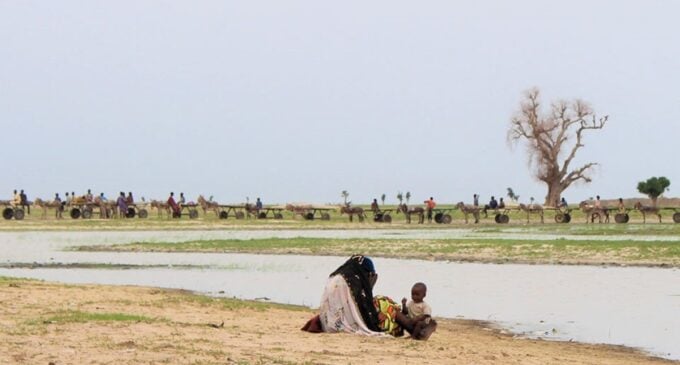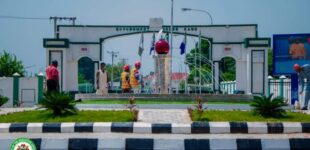Recharging the Lake Chad Basin on a win-win solution: A domesticated engineering solution

BY MUSTAFA BELLO AND BOE ADEBOSIN
It is indeed an irony that the Lake Chad basin is depleting while the country suffers from flooding yearly. The question this challenge throws at us is; what stops the country from harnessing and diverting the flooding water into the Lake Chad. Had this been a challenge to the Chinese it would have been addressed promptly. Why not by us?
Therefore, Engr. Mustafa Bello, a Fellow of the Nigerian Society of Engineers and a graduate of Civil Engineering, 1978 and his Associates are inviting the attention of the Federal Government of Nigeria, once again, given the pronouncements made by President Asiwaju Bola Ahmed Tinibu, GCFR, on using our domestic resources to recharge the lake, to consider the Recharge of Lake Chad with the Water that yearly causes devastating floods across the country. This is possible by a Civil Engineering Solution.
The floods, including the one we experienced in year 2022, were caused by the overflowing of River Niger and its main tributary, River Benue and also the Hadeja-Jemaare River.
This domesticated Solution that requires the dredging of the three major rivers – Niger; Benue; Hadeja-Jamaare will;
(1) Eventually achieve gradual recovery of Lake Chad such that there would be no need to continue the dream of importing water from the Congo basin to refill it with associated consequential ecological disaster.
(2) Resuscitation of inland Waterways in the country for cheap movement of cargo.
(3) Bring to an end the type of devastating floods witnessed across the country in year 2022.
Other associated benefits will include;
(4) Availability of large quantity of soil useful for crop farming and construction will be removed from the beds of these rivers for packaging and sales to our farmers and the construction industry;
(5) Large quantities of sand/river pebbles that will be removed from the beds of the rivers for packaging and sales to end-users.
(A) Before Now:
We may not have been fully aware of all the benefits the Federal Government expected from the Contract it awarded sometime between 2007 and 2011, to dredge the River Niger. But it was widely reported that the aim was to make the River Navigable from Baro in Niger State to the Estuary in the Niger delta area of the country.
(B) Beyond Now:
We are given to believe, by this paper, the benefits of dredging River Niger can be expanded to include transfer of excess water to the Lake Chad.
This transfer should be augmented by additional transfers from River Benue and the Hadeja-Jemaare River using designed hydraulic structures.
These dredging and water transfers will be designed to end the type of flooding witnessed in 2022 in Jigawa, Kano, Taraba, Adamawa, Benue, Kogi, Niger, Anambra, Delta, Rivers, Bayelsa States, etc.
(C) So:
i. With data from the dredging project of the River Niger we will know if the Channel, after the designed dredging, can contain a flow that will prevent the type of flooding the country witnessed in year 2022 or would require further deepening.
ii. From the document we will know if a study for dredging River Benue, a tributary of River Niger is in place.
iii. Following the review of the Design Report mentioned above, we will prepare an appropriate recommendation to government.
iv. Meanwhile, because we do not think dredging the Hadeja-Jemaare River is under consideration, we suggest the government considers doing so as well being a major tributary.
(D) Finally:
Government should lean on our domestic Engineering capabilities to design the facilities that will enable Water Transfer from these Rivers ( Niger, Benue and Hadeja-Jemaare) to Lake Chad. We are willing to share our knowledge on this with whoever is selected
Executive summary
The Lake Chad Basin Commission (LCBC) member countries, led by Nigeria, have agreed to recharge Lake Chad by constructing a 2,500 kilometre long navigable channel, to bring water to the Lake from the Congo Basin that is in the Democratic Republic of Congo (DRC).
It is estimated that an amount in the region of $30 billion-$50 billion may be required to develop this channel, including about $600m for Engineering Studies, Design, Project Management and Environment Impact Assessment (E.I.A) studies.
Efforts to mobilize the required funding is in progress, but we foresee this may not be available in the coming years, if not decades. It may remain a mirage.
Meanwhile, we believe the Federal Government can channelize and use the water from Rivers Niger and Benue that cause perennial flooding in many states of the country, to gradually refill the Lake via the Hadejia – Jema’are – Komadugu – Yobe River, which currently contributes about three-percent (3%) of the flow into the Lake. Other tributaries will actively contribute if properly channelized to feed into the major artery feeding this lake.
In essence, we are requesting the Federal Government to consider widening and deepening (i.e; dredging) Rivers Niger and Benue, to end the annual flooding caused by siltation in them; then use part of the water in these widened and deepened rivers, to refill Lake Chad on a sustainable mode.
This will be a case of government ending seasonal flooding and refilling Lake Chad, concurrently.
In respect of this, we are happy to inform government, we, the proponents of this Solution, are able and available to provide all the Professional support needed for implementing this solution – hence, we call it ‘a domesticated solution’ – a solution developed by Nigerian Engineers based on using water taken from within the sources in Nigeria.
Other benefits the country will derive by adopting this domesticated solution, include:
- All of River Benue that is within Nigeria, will become navigable
- A good segment of River Niger will become navigable within Nigeria.
- The Hadejia-Jema’are-Komadugu-Yobe River will become navigable
- It is expected the soil removed from the rivers by dredging, can be used as top soil in agricultural fields or the for construction industry.
- The widened and deepened Hadejia-Jema’are-Komadugu-Yobe River, can be used to develop the Nguru wetlands for all-year-round agriculture-crop and animal farming
Why River Niger instead of the Congo River
River Niger which is about 4,200 kilometres long, is the third longest river in our Continent. From its source at an elevation of about 800 metres above the sea level in the Fouta Djallon highlands that is in the Republic of Guinea, it flows into the Atlantic Ocean through Guinea, Mali, Niger, Benin and Nigeria. Also, watersheds in Cote d’ivore, Burkina Faso, Chad and Cameroon, contribute to the flow in the River.
Hydrological data from the Nigeria Hydrological Services Agency (NHSA) shows, Nigeria which is geographically located downstream of Rivers Niger and Benue, has in recent years, experienced floods during the months of August, September and October – so far, the worst (on record) occurred in 2012 and 2022, when a discharge of over 31,000 cum/sec was measured.
Furthermore, the data convinced us, the section of River Niger that is within Nigeria can be a good source of Recharging the Shrinking Lake.
It is the opinion of the proponents of this paper, that using River Niger to recharge the Lake will bring abundant benefits to the country, this can include, an opportunity for an al year round agricultural activities, in addition to the other benefits listed in the Executive Summary.
The benefit to the country can also include turning the Nguru wetlands, which is presently a marshy area outgrown with wild grass, into a productive agricultural area.
Advantages of Recharging Lake Chad through River Niger instead of River Congo
- The Estimated Capital Expenditure (CAPEX) for this ‘domesticated solution’, is about USD2.5 – 5.0 billion – which is less than 10% of the USD30-50 billion the member states of the LCBC are looking for, to construct a 2,500 kilometres navigable channel between River Congo and the Lake Chad,
- River Niger originates & flows through the countries of the Lake Chad Basin Commission (LCBC), therefore the likelihood of future political interference remains very remote.
- Existing dams within Nigeria can be integrated with the water transferred from River Niger creating an extensive network of Irrigation infrastructure that enables all year round agricultural activity,
- Mitigation of floods and Drought within the country.
- Availability of Navigable Inland Waterways within the country.
- Mitigation of effects of the worldwide climate change and southern movement of the Sahara Desert.
- Possibility of developing the Nguru wetlands to an extensive agricultural area for crop, vegetable and livestock farming.
- We can integrate existing Irrigation hydraulic structures to support the entire people of the sub-region.
- The $600M required for the feasibility studies of the proposed ‘River Congo to Lake Chad’ solution, becomes part of the CAPEX for this ‘domesticated solution’.
Conclusion
Since the water in River Niger belongs to the member countries of the Lake Chad Basin Commission (LCBC), using the river to recharge Lake Chad is more secured than taking water from River Congo which will ultimately become prone to utilization costs. Also, water from River Congo can come along with a variety of ecological challenges, including foreign diseases that can destroy our aquatic lives and even humans. Furthermore, it is possible the DRC authorities may demand for annual compensation that can be in Millions of USD, in future, thereby adding annual recurrent & overhead costs to the project.
We therefore, strongly, recommend that the Government of Nigeria, pause and take a look at this alternative Solution, a Flood Water Conservation Option (domesticated solution), for which we are available to provide amplification and guidance, that is cheaper and more cost effective, than continuing with the worldwide effort being made currently to mobilize about $30 – $50 billion for the transboundary River Basin Water Transfer to Lake Chad from River Congo, which may remain a mirage for a very long time to come.
Bello, FNSE, former minister of commerce, and Adebosin, MICE, are engineers. Data input by Ibrahim Olomoda, FNSE.
——————————–
The full title of this paper is ‘A case for deploying use of domestic flood control mechanism on River Niger and Benue in recharging the Lake Chad Basin on a win-win solution – a domesticated engineering solution’
Views expressed by contributors are strictly personal and not of TheCable.

















There are no comments at the moment, do you want to add one?
Write a comment